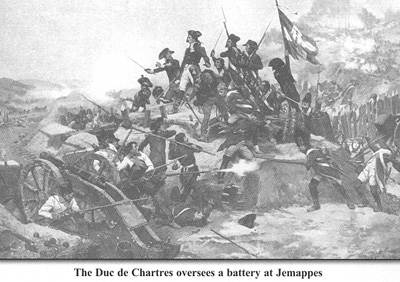Battlefield Use Of Napoleonic Artillery
Where to Place and What to Fire At
by Keith Webb, UK
| |
A helpful analysis of the command arrangements for British and French artillery is contained in B.P.Hughes’ book “Artillery Tactics from Marlborough to Wellington” from which much of the following is derived. The Duc de Chartres oversees a battery at Jemappes The basic organisational, administrative and tactical unit of artillery in all armies during the Napoleonic period was the battery. A battery’s higher command often lay with the army commander himself although there may be a commander of artillery or, particularly in the British army, separate commanders for horse and foot. During this period artillery was generally decentralised with individual batteries being assigned to support specific infantry or cavalry units – but not, as in earlier periods, generally to the extent of “battalion guns” although these appear to have been reintroduced into the French army in the latter part of the period. On the contrary, the French army made significant use of an arrangement whereby many batteries where located adjacent to one another to form a “grand battery”. Although a battery’s position may have been chosen for it by a senior officer, the choice of target, of projectile and of when to fire lay with the battery commander. The choice of which part of the target to aim for was the responsibility of the “number one” of each individual gun crew. This was the case even when several batteries were brought together into the famed “grand battery” since there was no overall command structure or communication system, which could direct the fire of all the guns onto the same target. Hughes ( [1] , p.88) suggests that while the effect
on the enemy’s morale of such a huge array of
guns must have been great, it is doubtful
whether its technical effectiveness increased
in direct proportion to the number of guns
deployed. It might be thought, for instance,
that the appalling casualties suffered by the
Inniskillings at Waterloo demonstrated the
effectiveness of the “grand battery”.
Hughes, however, cites Waterloo as an example of the
“grand battery’s” relative ineffectiveness.
Despite the casualties suffered, the Inniskillings
remained in their place in the allied line and to
that extent the "grand battery” was ineffective.
Since that battery’s only real success was to
lower the morale of Bijlandt’s Dutch-Belgian
brigade to a level which caused them to leave
the field the “grand battery” failed to fulfil the
primary purpose of artillery which was to
“crush the (Allies) will to resist” ( [1] , p.76)
Each battery (if not each individual gun
since they each had to individually relaid
after every shot) was effectively an autonomous
tactical unit, physically located and
commanded independently of any other, there
being no basis on which batteries could co-ordinate
their fire against the same target even
when a number of batteries were situated adjacent
cent to each other as a “grand battery”. So,
what were the factors, which determined the siting of a battery?
Battlefield Use Of Napoleonic Artillery Where to Place and What to Fire At
|
 Command And Control
Command And Control